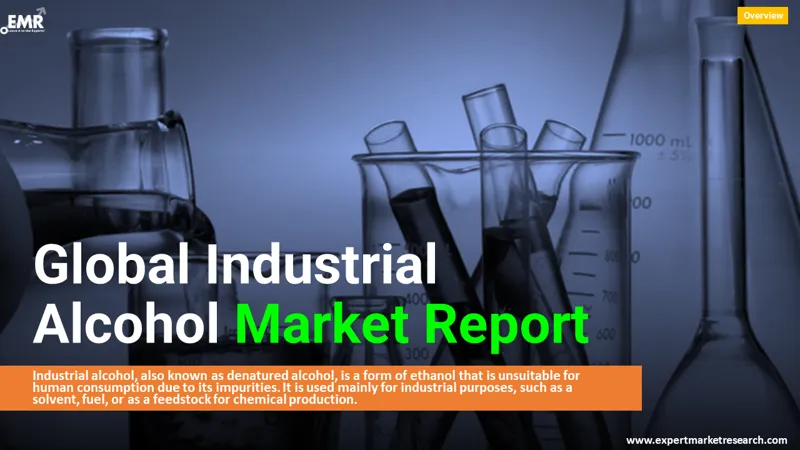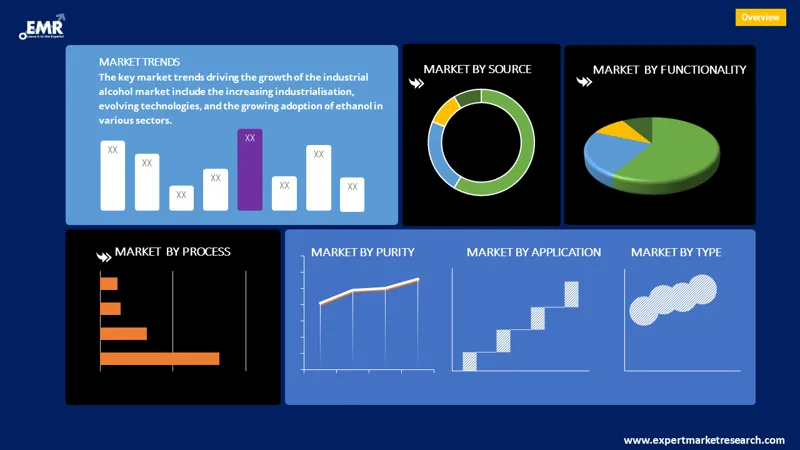
Consumer Insights
Uncover trends and behaviors shaping consumer choices today
Procurement Insights
Optimize your sourcing strategy with key market data
Industry Stats
Stay ahead with the latest trends and market analysis.
The global industrial alcohol market size attained a value of nearly USD 163.31 Billion in 2025. The market is further estimated to grow in the forecast period of 2026-2035 at a CAGR of 7.90% to reach a value of around USD 349.32 Billion by 2035.
Base Year
Historical Period
Forecast Period
Compound Annual Growth Rate
7.9%
Value in USD Billion
2026-2035
*this image is indicative*
| Global Industrial Alcohol Market Report Summary | Description | Value |
| Base Year | USD Billion | 2025 |
| Historical Period | USD Billion | 2019-2025 |
| Forecast Period | USD Billion | 2026-2035 |
| Market Size 2025 | USD Billion | 163.31 |
| Market Size 2035 | USD Billion | 349.32 |
| CAGR 2019-2025 | Percentage | XX% |
| CAGR 2026-2035 | Percentage | 7.90% |
| CAGR 2026-2035 - Market by Region | Latin America | 8.5% |
| CAGR 2026-2035 - Market by Country | India | 9.4% |
| CAGR 2026-2035 - Market by Country | China | 8.4% |
| CAGR 2026-2035 - Market by Purity | Denatured Alcohol | 8.6% |
| CAGR 2026-2035 - Market by Source | Sugar and Molasses | 8.8% |
| Market Share by Country 2025 | Mexico | 2.4% |
The North American region has witnessed significant growth in the market share of industrial alcohol. This is on account of the vast plantations of ethanol along with increasing production of industrial solvents in the United States from agricultural wastes and algae. The surging adoption of ethanol for conveyance fuel and as a source of octane is further driving the market growth of industrial alcohol across North America.

Read more about this report - REQUEST FREE SAMPLE COPY IN PDF
Moreover, the Asia Pacific is anticipated to register substantial growth in the global industrial alcohol market on account of the increasing production of biofuel coupled with high ethanol consumption. Owing to the enhanced priority of reduction of greenhouse gas emissions across the globe coupled with lower oil consumption in the Asia Pacific, the market growth of industrial alcohol across the region is likely to fuel over the coming years. Rapid urbanisation and industrial sector development in countries like China and India are further influencing the market growth of the industrial alcohol across the region.
| CAGR 2026-2035 - Market by | Country |
| India | 9.4% |
| China | 8.4% |
| Saudi Arabia | 8.4% |
| Mexico | 8.3% |
| UK | 7.7% |
| USA | 7.5% |
| Canada | XX% |
| France | XX% |
| Italy | XX% |
| Japan | XX% |
| Australia | XX% |
| Brazil | XX% |
| Germany | 7.0% |
Industrial alcohol is an impure ethanol alcohol, that is not safe for human consumption, but is utilised for industrial applications, often as a solvent. It is most commonly available as an ethyl alcohol, completely denatured alcohol, and proprietary solvent blends. It is distilled ethyl alcohol, generally of high proof, produced for purposes other than consumption.
By type the industrial alcohol market is divided into:
On the basis of source, the market can be categorised into:
Based on purity, the market is segmented into:
By functionality, the market is segmented into:
On the basis of process, the market is segmented into:
Based on application, the market is categorised into:
Regional markets of industrial alcohol like

Read more about this report - REQUEST FREE SAMPLE COPY IN PDF
The surging demand for industrial alcohol in chemicals and petrochemicals industries due to common uses of the product like cosmetics, cleaners, fuels, pharmaceuticals, textiles, and pharmaceuticals, among others are driving the industrial alcohol market. Industrial alcohols find numerous applications in cosmetics, pharmaceuticals, and paints & coatings because of their multi-functional properties which is further propelling the market growth of industrial alcohol across the globe.
Going further, the growing industrialisation along with increasing production of ethanol due to the rising demand in various sectors is further expected to fuel the market demand for industrial alcohol during the forecast period. Based on type, the ethyl alcohol segment is holding a significant share in the market growth of industrial alcohol across the globe on account of the surging demand for ethanol from chemical industries. Moreover, the increasing usage of ethanol in petrol engines as a blending fuel for gasoline is further likely to drive the market growth of industrial alcohol.
The report presents a detailed analysis of the following key players in the global industrial alcohol market, looking into their type, market shares, and latest developments like type expansions, plant turnarounds, and mergers and acquisitions:
The comprehensive report looks into the macro and micro aspects of the market. The EMR report gives an in-depth insight into the market by providing a SWOT analysis as well as an analysis of Porter’s Five Forces model.




*While we strive to always give you current and accurate information, the numbers depicted on the website are indicative and may differ from the actual numbers in the main report. At Expert Market Research, we aim to bring you the latest insights and trends in the market. Using our analyses and forecasts, stakeholders can understand the market dynamics, navigate challenges, and capitalize on opportunities to make data-driven strategic decisions.*
Get in touch with us for a customized solution tailored to your unique requirements and save upto 35%!
In 2025, the global industrial alcohol market attained a value of nearly USD 163.31 Billion.
The market is assessed to grow at a CAGR of 7.90% between 2026 and 2035.
The market is estimated to witness healthy growth in the forecast period of 2026-2035 to reach almost USD 349.32 Billion by 2035.
The major market drivers are increasing urbanisation, use of industrial alcohol as a biofuel, and increased production.
The key market trends guiding the growth of the market include growing industrialisation, evolving technology, increasing adoption of ethanol in various sectors.
The major regions in the market are North America, Europe, the Asia Pacific, Latin America, and the Middle East and Africa.
The various types of industrial alcohols include ethyl alcohol, methyl alcohol, isopropyl, and isobutyl alcohol, among others.
The different sources available for industrial alcohol include fossil fuels, corn, grains, and sugar and molasses, among others.
The different purity in the market are denatured alcohol and undenatured alcohol.
The major market divisions, based on functionality, include antimicrobial activity, fragrant and flavouring agents, solubility, antifreeze, and flammability and volatility.
The major market divisions, on the basis of process, include the fermentation method and synthetic method.
The major market divisions, based on application, include personal care, food, fuels, chemical intermediates, and pharmaceuticals, among others.
The major players in the market are Cargill, Incorporated, Archer Daniels Midland Company, POET, LLC., Valero, Green Plains Inc., The Andersons Inc., Grain Millers, Inc., Greenfield Global Inc., Grain Processing Corporation, and Cristalco, among others.
Explore our key highlights of the report and gain a concise overview of key findings, trends, and actionable insights that will empower your strategic decisions.
| REPORT FEATURES | DETAILS |
| Base Year | 2025 |
| Historical Period | 2019-2025 |
| Forecast Period | 2026-2035 |
| Scope of the Report |
Historical and Forecast Trends, Industry Drivers and Constraints, Historical and Forecast Market Analysis by Segment:
|
| Breakup by Type |
|
| Breakup by Source |
|
| Breakup by Purity |
|
| Breakup by Functionality |
|
| Breakup by Process |
|
| Breakup by Application |
|
| Breakup by Region |
|
| Market Dynamics |
|
| Competitive Landscape |
|
| Companies Covered |
|
Single User License
One User
USD 3,999
USD 3,599
tax inclusive*
Datasheet
One User
USD 2,499
USD 2,249
tax inclusive*
Five User License
Five User
USD 4,999
USD 4,249
tax inclusive*
Corporate License
Unlimited Users
USD 5,999
USD 5,099
tax inclusive*
*Please note that the prices mentioned below are starting prices for each bundle type. Kindly contact our team for further details.*
Flash Bundle
Small Business Bundle
Growth Bundle
Enterprise Bundle
*Please note that the prices mentioned below are starting prices for each bundle type. Kindly contact our team for further details.*
Flash Bundle
Number of Reports: 3
20%
tax inclusive*
Small Business Bundle
Number of Reports: 5
25%
tax inclusive*
Growth Bundle
Number of Reports: 8
30%
tax inclusive*
Enterprise Bundle
Number of Reports: 10
35%
tax inclusive*
How To Order

Select License Type
Choose the right license for your needs and access rights.

Click on ‘Buy Now’
Add the report to your cart with one click and proceed to register.

Select Mode of Payment
Choose a payment option for a secure checkout. You will be redirected accordingly.
Gain insights to stay ahead and seize opportunities.

Get insights & trends for a competitive edge.

Track prices with detailed trend reports.

Analyse trade data for supply chain insights.

Leverage cost reports for smart savings

Enhance supply chain with partnerships.

Connect For More Information
Our expert team of analysts will offer full support and resolve any queries regarding the report, before and after the purchase.
Our expert team of analysts will offer full support and resolve any queries regarding the report, before and after the purchase.
We employ meticulous research methods, blending advanced analytics and expert insights to deliver accurate, actionable industry intelligence, staying ahead of competitors.
Our skilled analysts offer unparalleled competitive advantage with detailed insights on current and emerging markets, ensuring your strategic edge.
We offer an in-depth yet simplified presentation of industry insights and analysis to meet your specific requirements effectively.
Share